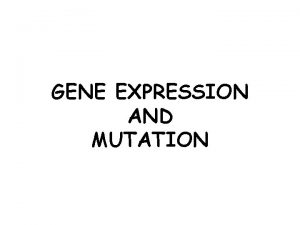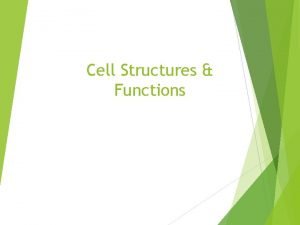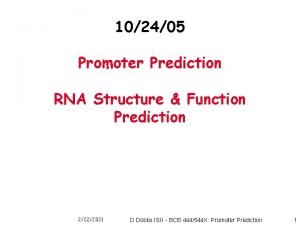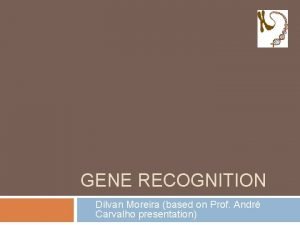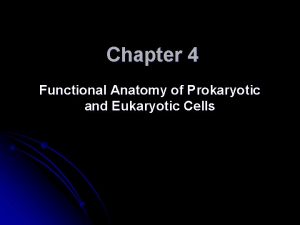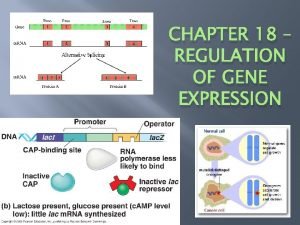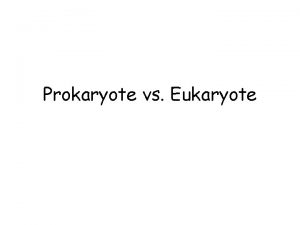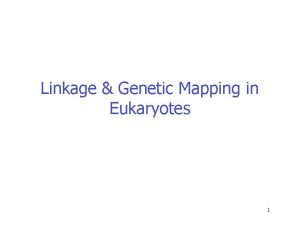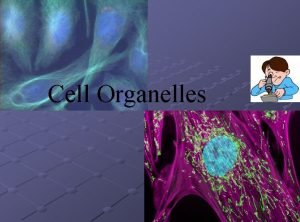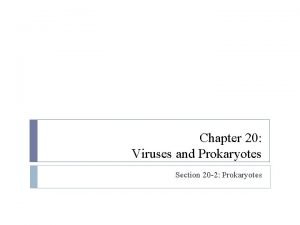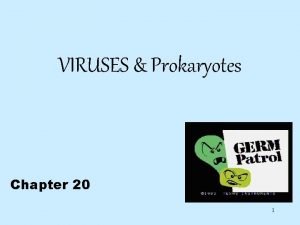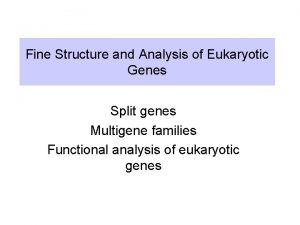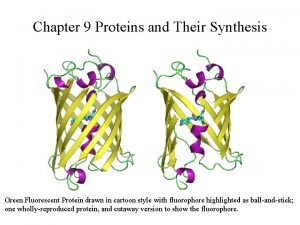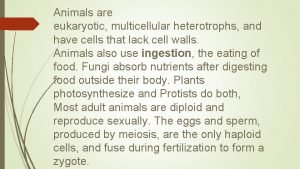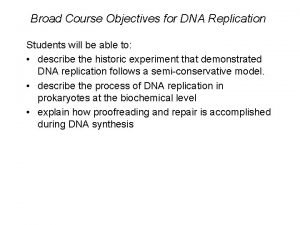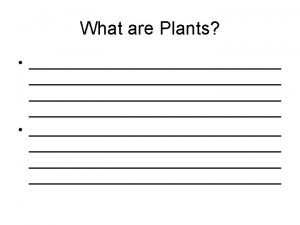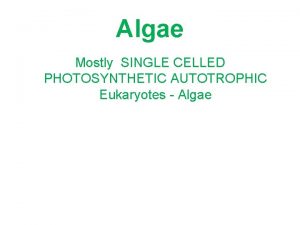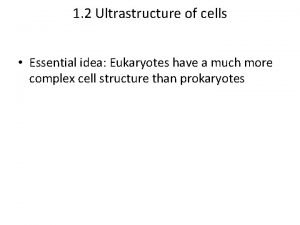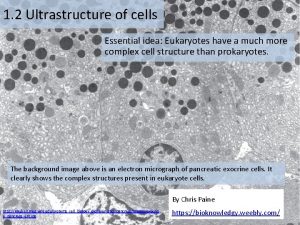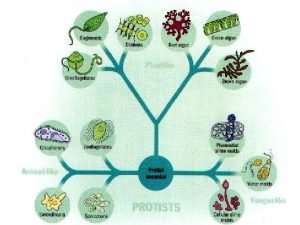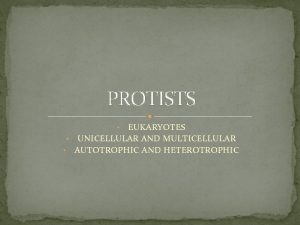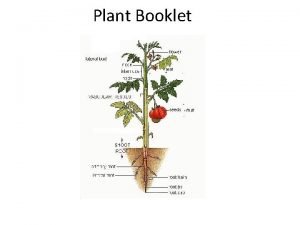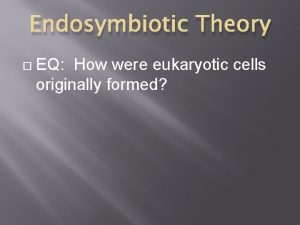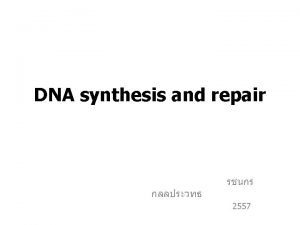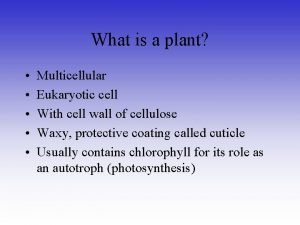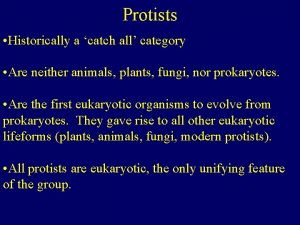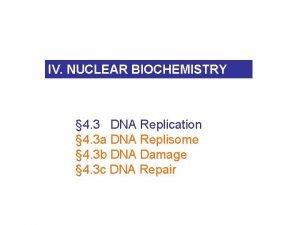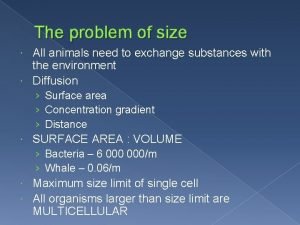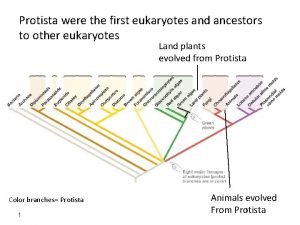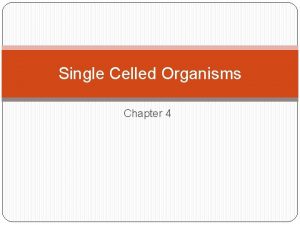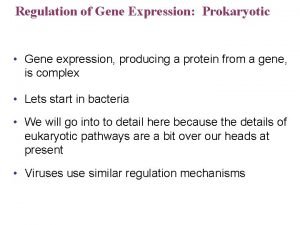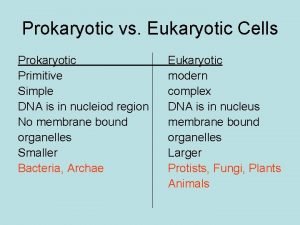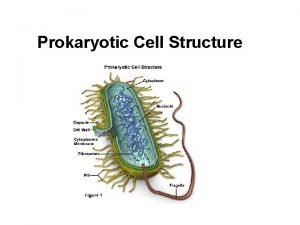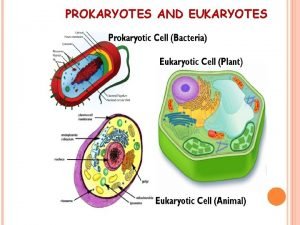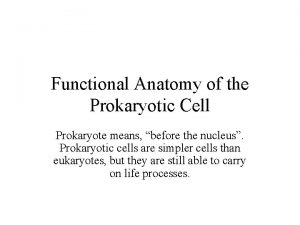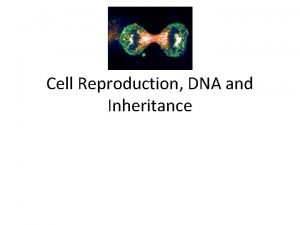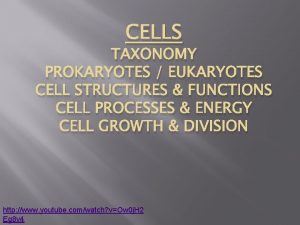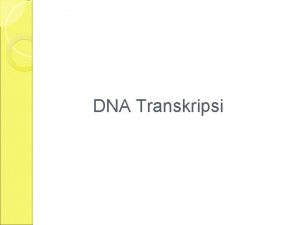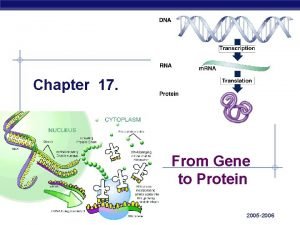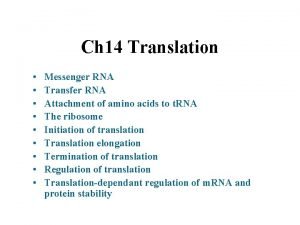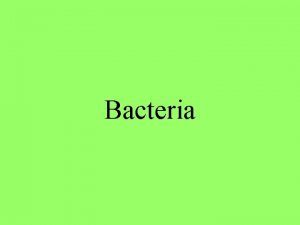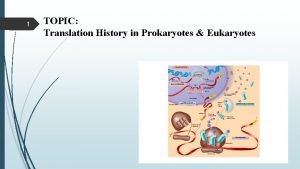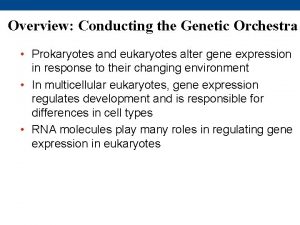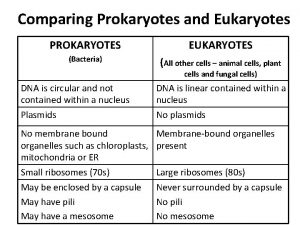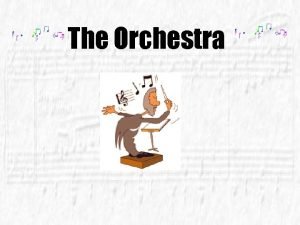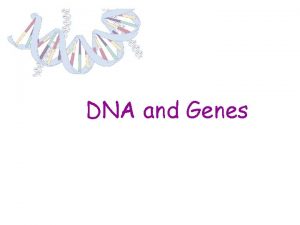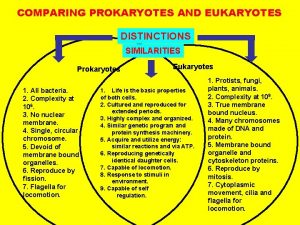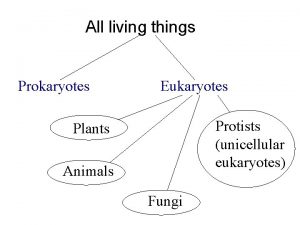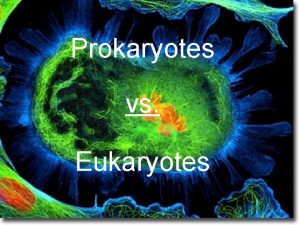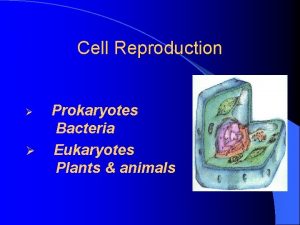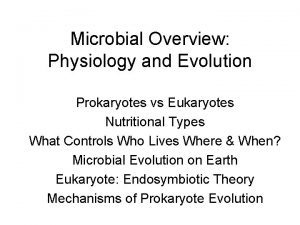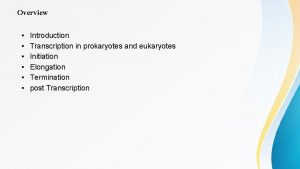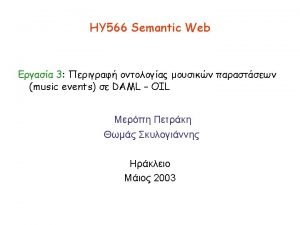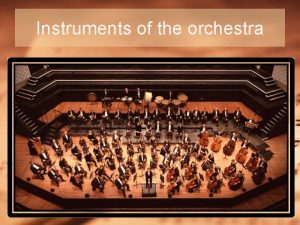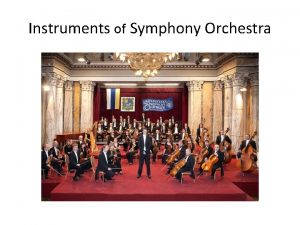Overview Conducting the Genetic Orchestra Prokaryotes and eukaryotes































































- Slides: 63

Overview: Conducting the Genetic Orchestra • Prokaryotes and eukaryotes alter gene expression in response to their changing environment • In multicellular eukaryotes, gene expression regulates development and is responsible for differences in cell types • RNA molecules play many roles in regulating gene expression in eukaryotes Copyright © 2008 Pearson Education Inc. , publishing as Pearson Benjamin Cummings

Concept 18. 1: Bacteria often respond to environmental change by regulating transcription • Natural selection has favored bacteria that produce only the products needed by that cell • A cell can regulate the production of enzymes by feedback inhibition or by gene regulation • Gene expression in bacteria is controlled by the operon model Copyright © 2008 Pearson Education Inc. , publishing as Pearson Benjamin Cummings

Fig. 18 -2 Precursor Feedback inhibition trp. E gene Enzyme 1 trp. D gene Regulation of gene expression Enzyme 2 trp. C gene trp. B gene Enzyme 3 trp. A gene Tryptophan (a) Regulation of enzyme activity (b) Regulation of enzyme production

Operons: The Basic Concept • A cluster of functionally related genes can be under coordinated control by a single on-off “switch” • The regulatory “switch” is a segment of DNA called an operator usually positioned within the promoter • An operon is the entire stretch of DNA that includes the operator, the promoter, and the genes that they control Copyright © 2008 Pearson Education Inc. , publishing as Pearson Benjamin Cummings

• The operon can be switched off by a protein repressor • The repressor prevents gene transcription by binding to the operator and blocking RNA polymerase • The repressor is the product of a separate regulatory gene Copyright © 2008 Pearson Education Inc. , publishing as Pearson Benjamin Cummings

• The repressor can be in an active or inactive form, depending on the presence of other molecules • A corepressor is a molecule that cooperates with a repressor protein to switch an operon off • For example, E. coli can synthesize the amino acid tryptophan Copyright © 2008 Pearson Education Inc. , publishing as Pearson Benjamin Cummings

• By default the trp operon is on and the genes for tryptophan synthesis are transcribed • When tryptophan is present, it binds to the trp repressor protein, which turns the operon off • The repressor is active only in the presence of its corepressor tryptophan; thus the trp operon is turned off (repressed) if tryptophan levels are high Copyright © 2008 Pearson Education Inc. , publishing as Pearson Benjamin Cummings

Fig. 18 -3 trp operon Promoter DNA trp. R Regulatory gene m. RNA 5 Protein Genes of operon trp. E Operator Start codon 3 m. RNA 5 polymerase E Inactive repressor trp. D trp. B trp. A B A Stop codon D C Polypeptide subunits that make up enzymes for tryptophan synthesis (a) Tryptophan absent, repressor inactive, operon on DNA No RNA made m. RNA Protein trp. C Active repressor Tryptophan (corepressor) (b) Tryptophan present, repressor active, operon off

Repressible and Inducible Operons: Two Types of Negative Gene Regulation • A repressible operon is one that is usually on; binding of a repressor to the operator shuts off transcription • The trp operon is a repressible operon • An inducible operon is one that is usually off; a molecule called an inducer inactivates the repressor and turns on transcription Copyright © 2008 Pearson Education Inc. , publishing as Pearson Benjamin Cummings

• The lac operon is an inducible operon and contains genes that code for enzymes used in the hydrolysis and metabolism of lactose • By itself, the lac repressor is active and switches the lac operon off • A molecule called an inducer inactivates the repressor to turn the lac operon on Copyright © 2008 Pearson Education Inc. , publishing as Pearson Benjamin Cummings

Fig. 18 -4 Regulatory gene Promoter Operator lac. Z lac. I DNA No RNA made 3 m. RNA polymerase 5 Active repressor Protein (a) Lactose absent, repressor active, operon off lac operon lac. Z lac. Y -Galactosidase Permease lac. I DNA 3 m. RNA 5 RNA polymerase m. RNA 5 Protein Allolactose (inducer) lac. A Inactive repressor (b) Lactose present, repressor inactive, operon on Transacetylase

• Inducible enzymes usually function in catabolic pathways; their synthesis is induced by a chemical signal • Repressible enzymes usually function in anabolic pathways; their synthesis is repressed by high levels of the end product • Regulation of the trp and lac operons involves negative control of genes because operons are switched off by the active form of the repressor Copyright © 2008 Pearson Education Inc. , publishing as Pearson Benjamin Cummings

Positive Gene Regulation • Some operons are also subject to positive control through a stimulatory protein, such as catabolite activator protein (CAP), an activator of transcription • When glucose (a preferred food source of E. coli) is scarce, CAP is activated by binding with cyclic AMP • Activated CAP attaches to the promoter of the lac operon and increases the affinity of RNA polymerase, thus accelerating transcription Copyright © 2008 Pearson Education Inc. , publishing as Pearson Benjamin Cummings

• When glucose levels increase, CAP detaches from the lac operon, and transcription returns to a normal rate • CAP helps regulate other operons that encode enzymes used in catabolic pathways Copyright © 2008 Pearson Education Inc. , publishing as Pearson Benjamin Cummings

Fig. 18 -5 Promoter Operator DNA lac. I lac. Z RNA polymerase binds and transcribes CAP-binding site Active CAP c. AMP Inactive CAP Inactive lac repressor Allolactose (a) Lactose present, glucose scarce (c. AMP level high): abundant lac m. RNA synthesized Promoter DNA lac. I CAP-binding site Inactive CAP Operator lac. Z RNA polymerase less likely to bind Inactive lac repressor (b) Lactose present, glucose present (c. AMP level low): little lac m. RNA synthesized

Concept 18. 2: Eukaryotic gene expression can be regulated at any stage • All organisms must regulate which genes are expressed at any given time • In multicellular organisms gene expression is essential for cell specialization Copyright © 2008 Pearson Education Inc. , publishing as Pearson Benjamin Cummings

Differential Gene Expression • Almost all the cells in an organism are genetically identical • Differences between cell types result from differential gene expression, the expression of different genes by cells with the same genome • Errors in gene expression can lead to diseases including cancer • Gene expression is regulated at many stages Copyright © 2008 Pearson Education Inc. , publishing as Pearson Benjamin Cummings

Fig. 18 -6 Signal NUCLEUS Chromatin modification DNA Gene available for transcription Gene Transcription RNA Exon Primary transcript Intron RNA processing Tail Cap m. RNA in nucleus Transport to cytoplasm CYTOPLASM m. RNA in cytoplasm Degradation of m. RNA Translatio n Polypeptide Protein processing Degradation of protein Active protein Transport to cellular destination Cellular function

Regulation of Chromatin Structure • Genes within highly packed heterochromatin are usually not expressed • Chemical modifications to histones and DNA of chromatin influence both chromatin structure and gene expression Copyright © 2008 Pearson Education Inc. , publishing as Pearson Benjamin Cummings

Histone Modifications • In histone acetylation, acetyl groups are attached to positively charged lysines in histone tails • This process loosens chromatin structure, thereby promoting the initiation of transcription • The addition of methyl groups (methylation) can condense chromatin; the addition of phosphate groups (phosphorylation) next to a methylated amino acid can loosen chromatin Copyright © 2008 Pearson Education Inc. , publishing as Pearson Benjamin Cummings

Fig. 18 -7 Histone tails DNA double helix Amino acids available for chemical modification (a) Histone tails protrude outward from a nucleosome Unacetylated histones Acetylated histones (b) Acetylation of histone tails promotes loose chromatin structure that permits transcription

DNA Methylation • DNA methylation, the addition of methyl groups to certain bases in DNA, is associated with reduced transcription in some species • DNA methylation cause long-term inactivation of genes in cellular differentiation • In genomic imprinting, methylation regulates expression of either the maternal or paternal alleles of certain genes at the start of development Copyright © 2008 Pearson Education Inc. , publishing as Pearson Benjamin Cummings

Epigenetic Inheritance • Although the chromatin modifications just discussed do not alter DNA sequence, they may be passed to future generations of cells • The inheritance of traits transmitted by mechanisms not directly involving the nucleotide sequence is called epigenetic inheritance Copyright © 2008 Pearson Education Inc. , publishing as Pearson Benjamin Cummings

Regulation of Transcription Initiation • Chromatin-modifying enzymes provide initial control of gene expression by making a region of DNA either more or less able to bind the transcription machinery Copyright © 2008 Pearson Education Inc. , publishing as Pearson Benjamin Cummings

Organization of a Typical Eukaryotic Gene • Associated with most eukaryotic genes are control elements, segments of noncoding DNA that help regulate transcription by binding certain proteins • Control elements and the proteins they bind are critical to the precise regulation of gene expression in different cell types Copyright © 2008 Pearson Education Inc. , publishing as Pearson Benjamin Cummings

Fig. 18 -8 -1 Enhancer (distal control elements) Poly-A signal sequence Termination region Proximal control elements Exon DNA Upstream Promoter Intron Exon Downstream

Fig. 18 -8 -2 Enhancer (distal control elements) Poly-A signal sequence Termination region Proximal control elements Exon DNA Upstream Intron Promoter Primary RNA transcript Intron Exon Downstream Transcription Exon 5 Exon Intron Exon Cleaved 3 end of primary transcript Poly-A signal

Fig. 18 -8 -3 Enhancer (distal control elements) Poly-A signal sequence Termination region Proximal control elements Exon DNA Upstream Intron Promoter Primary RNA transcript Intron Exon Downstream Transcription Exon 5 Exon Intron Exon RNA processing Cleaved 3 end of primary transcript Poly-A signal Intron RNA Coding segment m. RNA 3 5 Cap 5 U T R Start codon Stop codon 3 Poly-A U tail T R

The Roles of Transcription Factors • To initiate transcription, eukaryotic RNA polymerase requires the assistance of proteins called transcription factors • General transcription factors are essential for the transcription of all protein-coding genes • In eukaryotes, high levels of transcription of particular genes depend on control elements interacting with specific transcription factors Copyright © 2008 Pearson Education Inc. , publishing as Pearson Benjamin Cummings

Enhancers and Specific Transcription Factors • Proximal control elements are located close to the promoter • Distal control elements, groups of which are called enhancers, may be far away from a gene or even located in an intron Copyright © 2008 Pearson Education Inc. , publishing as Pearson Benjamin Cummings

• An activator is a protein that binds to an enhancer and stimulates transcription of a gene • Bound activators cause mediator proteins to interact with proteins at the promoter Copyright © 2008 Pearson Education Inc. , publishing as Pearson Benjamin Cummings

Fig. 18 -9 -3 Promoter Activators DNA Enhancer Distal control element Gene TATA box General transcription factors DNA-bending protein Group of mediator proteins RNA polymerase II Transcription initiation complex RNA synthesis

• Some transcription factors function as repressors, inhibiting expression of a particular gene • Some activators and repressors act indirectly by influencing chromatin structure to promote or silence transcription Copyright © 2008 Pearson Education Inc. , publishing as Pearson Benjamin Cummings

Fig. 18 -10 Enhancer Promoter Control elements Albumin gene Crystallin gene LIVER CELL NUCLEUS Available activators LENS CELL NUCLEUS Available activators Albumin gene not expressed Albumin gene expressed Crystallin gene not expressed (a) Liver cell Crystallin gene expressed (b) Lens cell

Coordinately Controlled Genes in Eukaryotes • Unlike the genes of a prokaryotic operon, each of the coordinately controlled eukaryotic genes has a promoter and control elements • These genes can be scattered over different chromosomes, but each has the same combination of control elements • Copies of the activators recognize specific control elements and promote simultaneous transcription of the genes Copyright © 2008 Pearson Education Inc. , publishing as Pearson Benjamin Cummings

Mechanisms of Post-Transcriptional Regulation • Transcription alone does not account for gene expression • Regulatory mechanisms can operate at various stages after transcription • Such mechanisms allow a cell to fine-tune gene expression rapidly in response to environmental changes Copyright © 2008 Pearson Education Inc. , publishing as Pearson Benjamin Cummings

RNA Processing • In alternative RNA splicing, different m. RNA molecules are produced from the same primary transcript, depending on which RNA segments are treated as exons and which as introns Copyright © 2008 Pearson Education Inc. , publishing as Pearson Benjamin Cummings

Fig. 18 -11 Exons DNA Troponin T gene Primary RNA transcript RNA splicing m. RNA or

m. RNA Degradation • The life span of m. RNA molecules in the cytoplasm is a key to determining protein synthesis • Eukaryotic m. RNA is more long lived than prokaryotic m. RNA • The m. RNA life span is determined in part by sequences in the leader and trailer regions Copyright © 2008 Pearson Education Inc. , publishing as Pearson Benjamin Cummings

Protein Processing and Degradation • After translation, various types of protein processing, including cleavage and the addition of chemical groups, are subject to control • Proteasomes are giant protein complexes that bind protein molecules and degrade them Copyright © 2008 Pearson Education Inc. , publishing as Pearson Benjamin Cummings

Fig. 18 -12 Ubiquitin Proteasome Protein to be degraded Ubiquitinated protein Proteasome and ubiquitin to be recycled Protein entering a proteasome Protein fragments (peptides)

Concept 18. 3: Noncoding RNAs play multiple roles in controlling gene expression • Only a small fraction of DNA codes for proteins, r. RNA, and t. RNA • A significant amount of the genome may be transcribed into noncoding RNAs • Noncoding RNAs regulate gene expression at two points: m. RNA translation and chromatin configuration Copyright © 2008 Pearson Education Inc. , publishing as Pearson Benjamin Cummings

Effects on m. RNAs by Micro. RNAs and Small Interfering RNAs • Micro. RNAs (mi. RNAs) are small singlestranded RNA molecules that can bind to m. RNA • These can degrade m. RNA or block its translation Copyright © 2008 Pearson Education Inc. , publishing as Pearson Benjamin Cummings

Fig. 18 -13 Hairpin mi. RNA Hydrogen bond Dicer mi. RNA 5 3 (a) Primary mi. RNA transcript m. RNA degraded mi. RNAprotein complex Translation blocked (b) Generation and function of mi. RNAs

• The phenomenon of inhibition of gene expression by RNA molecules is called RNA interference (RNAi) • RNAi is caused by small interfering RNAs (si. RNAs) • si. RNAs and mi. RNAs are similar but form from different RNA precursors Copyright © 2008 Pearson Education Inc. , publishing as Pearson Benjamin Cummings

Chromatin Remodeling and Silencing of Transcription by Small RNAs • si. RNAs play a role in heterochromatin formation and can block large regions of the chromosome • Small RNAs may also block transcription of specific genes Copyright © 2008 Pearson Education Inc. , publishing as Pearson Benjamin Cummings

Concept 18. 4: A program of differential gene expression leads to the different cell types in a multicellular organism • During embryonic development, a fertilized egg gives rise to many different cell types • Cell types are organized successively into tissues, organ systems, and the whole organism • Gene expression orchestrates the developmental programs of animals Copyright © 2008 Pearson Education Inc. , publishing as Pearson Benjamin Cummings

A Genetic Program for Embryonic Development • The transformation from zygote to adult results from cell division, cell differentiation, and morphogenesis Copyright © 2008 Pearson Education Inc. , publishing as Pearson Benjamin Cummings

• Cell differentiation is the process by which cells become specialized in structure and function • The physical processes that give an organism its shape constitute morphogenesis • Differential gene expression results from genes being regulated differently in each cell type • Materials in the egg can set up gene regulation that is carried out as cells divide Copyright © 2008 Pearson Education Inc. , publishing as Pearson Benjamin Cummings

Sequential Regulation of Gene Expression During Cellular Differentiation • Determination commits a cell to its final fate • Determination precedes differentiation • Cell differentiation is marked by the production of tissue-specific proteins Copyright © 2008 Pearson Education Inc. , publishing as Pearson Benjamin Cummings

Pattern Formation: Setting Up the Body Plan • Pattern formation is the development of a spatial organization of tissues and organs • In animals, pattern formation begins with the establishment of the major axes • Positional information, the molecular cues that control pattern formation, tells a cell its location relative to the body axes and to neighboring cells Copyright © 2008 Pearson Education Inc. , publishing as Pearson Benjamin Cummings

Concept 18. 5: Cancer results from genetic changes that affect cell cycle control • The gene regulation systems that go wrong during cancer are the very same systems involved in embryonic development Copyright © 2008 Pearson Education Inc. , publishing as Pearson Benjamin Cummings

Types of Genes Associated with Cancer • Cancer can be caused by mutations to genes that regulate cell growth and division • Tumor viruses can cause cancer in animals including humans Copyright © 2008 Pearson Education Inc. , publishing as Pearson Benjamin Cummings

Oncogenes and Proto-Oncogenes • Oncogenes are cancer-causing genes • Proto-oncogenes are the corresponding normal cellular genes that are responsible for normal cell growth and division • Conversion of a proto-oncogene to an oncogene can lead to abnormal stimulation of the cell cycle Copyright © 2008 Pearson Education Inc. , publishing as Pearson Benjamin Cummings

Fig. 18 -20 Proto-oncogene DNA Translocation or transposition: Point mutation: Gene amplification: within a control element New promoter Normal growthstimulating protein in excess Oncogene Normal growth-stimulating protein in excess Normal growthstimulating protein in excess within the gene Oncogene Hyperactive or degradationresistant protein

• Proto-oncogenes can be converted to oncogenes by – Movement of DNA within the genome: if it ends up near an active promoter, transcription may increase – Amplification of a proto-oncogene: increases the number of copies of the gene – Point mutations in the proto-oncogene or its control elements: causes an increase in gene expression Copyright © 2008 Pearson Education Inc. , publishing as Pearson Benjamin Cummings

Tumor-Suppressor Genes • Tumor-suppressor genes help prevent uncontrolled cell growth • Mutations that decrease protein products of tumor-suppressor genes may contribute to cancer onset • Tumor-suppressor proteins – Repair damaged DNA – Control cell adhesion – Inhibit the cell cycle in the cell-signaling pathway Copyright © 2008 Pearson Education Inc. , publishing as Pearson Benjamin Cummings

Interference with Normal Cell-Signaling Pathways • Mutations in the ras proto-oncogene and p 53 tumor-suppressor gene are common in human cancers • Mutations in the ras gene can lead to production of a hyperactive Ras protein and increased cell division Copyright © 2008 Pearson Education Inc. , publishing as Pearson Benjamin Cummings

Fig. 18 -21 1 Growth factor MUTATION Hyperactive Ras protein (product of oncogene) issues signals on its own Ras 3 G protein GTP Ras GTP 2 Receptor 4 Protein kinases (phosphorylation cascade) NUCLEUS 5 Transcription factor (activator) DNA Gene expression Protein that stimulates the cell cycle (a) Cell cycle–stimulating pathway 2 Protein kinases MUTATION 3 Active form of p 53 UV light 1 DNA damage in genome Defective or missing transcription factor, such as p 53, cannot activate transcription DNA Protein that inhibits the cell cycle (b) Cell cycle–inhibiting pathway EFFECTS OF MUTATIONS Protein overexpressed Cell cycle overstimulated (c) Effects of mutations Protein absent Increased cell division Cell cycle not inhibited

• Suppression of the cell cycle can be important in the case of damage to a cell’s DNA; p 53 prevents a cell from passing on mutations due to DNA damage • Mutations in the p 53 gene prevent suppression of the cell cycle Copyright © 2008 Pearson Education Inc. , publishing as Pearson Benjamin Cummings

The Multistep Model of Cancer Development • Multiple mutations are generally needed for fullfledged cancer; thus the incidence increases with age • At the DNA level, a cancerous cell is usually characterized by at least one active oncogene and the mutation of several tumor-suppressor genes Copyright © 2008 Pearson Education Inc. , publishing as Pearson Benjamin Cummings

Fig. 18 -22 c 2 Activation of ras oncogene 3 Loss of tumor-suppressor gene DCC Larger benign growth (adenoma)

Inherited Predisposition and Other Factors Contributing to Cancer • Individuals can inherit oncogenes or mutant alleles of tumor-suppressor genes • Inherited mutations in the tumor-suppressor gene adenomatous polyposis coli are common in individuals with colorectal cancer • Mutations in the BRCA 1 or BRCA 2 gene are found in at least half of inherited breast cancers Copyright © 2008 Pearson Education Inc. , publishing as Pearson Benjamin Cummings
 Diff between prokaryotes and eukaryotes
Diff between prokaryotes and eukaryotes Prokaryotes and eukaryotes
Prokaryotes and eukaryotes Is protist a prokaryote or eukaryote
Is protist a prokaryote or eukaryote Multiple choice questions on prokaryotes and eukaryotes
Multiple choice questions on prokaryotes and eukaryotes Gene prediction in prokaryotes and eukaryotes
Gene prediction in prokaryotes and eukaryotes Prokaryotes vs eukaryotes gene regulation
Prokaryotes vs eukaryotes gene regulation Polimerase
Polimerase Prokaryotic cell wall
Prokaryotic cell wall Anatomy of prokaryotes and eukaryotes
Anatomy of prokaryotes and eukaryotes Transcription in prokaryotes vs eukaryotes
Transcription in prokaryotes vs eukaryotes Prokaryotes vs eukaryotes gene regulation
Prokaryotes vs eukaryotes gene regulation Prokaryotes vs eukaryotes venn diagram
Prokaryotes vs eukaryotes venn diagram Is bacteria prokaryotic or eukaryotic
Is bacteria prokaryotic or eukaryotic Prokaryotes vs eukaryotes
Prokaryotes vs eukaryotes Prokaryotes vs eukaryotes chart
Prokaryotes vs eukaryotes chart Prokaryotic cells
Prokaryotic cells Chi square test for linkage
Chi square test for linkage Founder effect genetic drift
Founder effect genetic drift Genetic programming vs genetic algorithm
Genetic programming vs genetic algorithm Genetic programming vs genetic algorithm
Genetic programming vs genetic algorithm What is gene flow and genetic drift
What is gene flow and genetic drift Genetic drift vs genetic flow
Genetic drift vs genetic flow Cytoskeleton prokaryotic or eukaryotic
Cytoskeleton prokaryotic or eukaryotic Chapter 20 viruses and prokaryotes
Chapter 20 viruses and prokaryotes Chapter 20 viruses and prokaryotes
Chapter 20 viruses and prokaryotes Section 1 studying viruses and prokaryotes
Section 1 studying viruses and prokaryotes Meaning of multicellular
Meaning of multicellular Rho independent termination
Rho independent termination Eukarya fungi
Eukarya fungi Fine structure analysis of eukaryotes
Fine structure analysis of eukaryotes Translation in bacteria vs eukaryotes
Translation in bacteria vs eukaryotes All animals are multicellular heterotrophic eukaryotes
All animals are multicellular heterotrophic eukaryotes Prokaryotic cell and eukaryotic cell similarities
Prokaryotic cell and eukaryotic cell similarities Linear chromosomes in eukaryotes
Linear chromosomes in eukaryotes Plants are multicellular eukaryotes
Plants are multicellular eukaryotes Transcription
Transcription Types of dna polymerase in eukaryotes
Types of dna polymerase in eukaryotes Algae are autotrophic. *
Algae are autotrophic. * Eukaryotes main idea
Eukaryotes main idea Eukaryotes main idea
Eukaryotes main idea Polyphyletic group
Polyphyletic group Are protists heterotrophic or autotrophic
Are protists heterotrophic or autotrophic Plant tissue
Plant tissue Aerobic eukaryotes
Aerobic eukaryotes Helicaee
Helicaee Plants are multicellular eukaryotes
Plants are multicellular eukaryotes Catch all category
Catch all category Nucleotide in dna replication
Nucleotide in dna replication Heterogamy in eukaryotes
Heterogamy in eukaryotes Protist evolution
Protist evolution Plants are multicellular eukaryotes
Plants are multicellular eukaryotes Single cell organisms
Single cell organisms Prokaryotic gene expression
Prokaryotic gene expression Paramecium prokaryotic or eukaryotic
Paramecium prokaryotic or eukaryotic Mesosome in bacteria
Mesosome in bacteria What is eukaryotic and prokaryotic
What is eukaryotic and prokaryotic Prokaryotic cells characteristics
Prokaryotic cells characteristics Prophase 1
Prophase 1 King phillip came over from great spain
King phillip came over from great spain Termination of transcription in prokaryotes
Termination of transcription in prokaryotes Transcription in prokaryotes
Transcription in prokaryotes Translation in prokaryotes
Translation in prokaryotes Unicellular prokaryotes kingdom
Unicellular prokaryotes kingdom Elongation of translation in prokaryotes
Elongation of translation in prokaryotes
